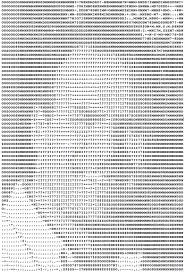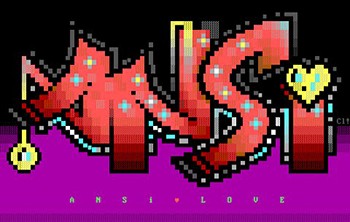What is ASCII Art?ASCII art is the process of creating graphics or art with the help of using the ASCII text characters; it is also known as ANSI art, text art, or word art. The graphics are made by beginning from scratch and using the characters to approximate anything or by manually converting an existing image to ASCII characters. Before the Internet and broadband, when users connected using a BBS, these images were popular. In modern times, ASCII art may still be found on the Internet, and it is a popular way to make a unique image. As more characters are employed in order to produce the image, ASCII art progresses from simple to photo-realistic. ASCII art is very much close to emotions in that it can be used to add a touch of levity to a communication or document. The more detailed ASCII art accurately translates renowned individuals, landscapes, as well as other objects into ASCII. The applications of ASCII art are emails, online pages, and documents; generally, pretty much anyplace ASCII characters can be entered. Because early printers lacked visual capacity, characters were employed in place of graphic markers, which led to the invention of ASCII art in large part. Bulk printers also used ASCII graphics to produce large banner pages to distinguish divisions between separate print jobs from different users, making the divisions simpler to see so that the output could be split by a computer operator or clerk. When photos couldn't be incorporated in early e-mail, ASCII art was used instead. Example of ASCII artCaptain Kirk from the original Star Trek series is depicted in the image below, which is an example of ASCII art. The artist (or algorithm) chooses the characters, numbers, as well as punctuation marks on the basis of the glyph's shape and content. For example, in comic books, a slash (/) can be used to create a cross-hatching effect. 
ANSI artANSI art encodes foreground and background text colours with the help of using ANSI escape code sequences; however, it is much like to ASCII art. In addition to alphanumeric letters, it makes greater use of extended ASCII characters, which may depict forms and patterns. ANSI art grew increasingly popular in the 1980s, as more home computers offered standardized colour screens. 
TheDraw TheDraw, a shareware ANSI text editor created by software author Ian E. Davis in 1986, led to improving popularity as well as the accessibility of the ANSI art form. TheDraw also allowed for the animation of drawings through the smart use of ANSI escape sequences. ANSI packs ANSI artists packed and released their work as zipped ANSI packs in the late 1980s and early 1990s, which helped to create a competitive art community. These packages had the same purpose as a traditional artist, who gathered and presented his or her work in an art gallery. The text-based BBS was overtaken as the major form of personal networking by the World Wide Web in the late 1990s as consumer operating systems moved away from console user interfaces. ANSI art lost popularity as a result of this shift in a technological culture, but it remains a minor art form with a cult following. PabloDraw PabloDraw can be downloaded from the PabloDraw website, which is a modern open-source ANSI and ASCII text editor. History of ASCII artTypewriter art Typewriters have been used to create visual art since 1867. TTY and RTTY TTY is short for "TeleTYpewriter" or "TeleTYpe," and it's also known as Teleprinter or Teletype. The term RTTY refers to the use of character sets such as Baudot coding, which predated ASCII. Text images were sent via teletypewriter as early as 1923, according to a chapter in the "RTTY Handbook." On the other hand, no "old" RTTY art has yet to be uncovered. What is known is that in the 1960s and 1970s, text images often appeared on radioteletype. Line-printer art A drawing of an electronic circuit printed was presented by Andries van Dam using an IBM 1403-line printer in the 1960s. Kenneth Knowlton, on the other hand, was employing line printers to produce realistic designs by overprinting multiple characters on top of one another. Despite certain glyph similarities, 1403 was not ASCII art in the sense that it was powered by an EBCDIC-coded platform, with EBCDIC-generated character sets and trains. ASCII art In the late 1970s and early 1980s, computer bulletin board systems and the widespread use of ASCII art may be traced. At that time, text characters were used to represent images because of the limitations of computers. Along with its use in communication, ASCII started to show up in the underground online art communities of the time. An ASCII comic uses ASCII text to create images as it is a type of webcomic. ASCII art is used in place of visuals in a traditional comic, with the text or dialogue that is generally placed underneath. Variable-width typefaces and graphic browsing became increasingly popular in the 1990s, resulting in a fall in ASCII art. Despite this, ASCII art has survived Internet Relay Chat, Email, message boards, and other forms of online communication that employ the needed fixed-width characters, thanks to online MUDs (textual multiplayer role-playing video games). ANSI The early technical age was defined by ASCII and, more crucially, ANSI; terminal systems dependent upon a consistent presentation employing colour as well as control signals that were standard in terminal protocols. Warez organizations started to emerge in the ASCII art community with the time. Also, .nfo files are commonly distributed with warez software, cracks, and other software reverse-engineering releases.. Typically, the ASCII graphics will include the name of the warez organization and may include some ASCII borders on the release notes' outsides, etc. Most DOS and similar console software, as well as the forerunner to AOL, were based upon ASCII and ANSI art. Uses of ASCII artAs it has been described in the beginning of the page, ASCII art is the process of creating graphics or art using the ASCII text characters. Therefore, if the transmission of pictures is not possible, or whenever text can be printed or transferred more easily than graphics, ASCII art is utilized in these kinds of conditions. This includes printer separators, teleprinters, email, Usenet news bulletins, non-graphic computer terminals, typewriters, as well as early computer networking (e.g., BBSes). Also, ASCII art is utilized in computer systems' source code to represent corporate or product logos, as well as flow control or other diagrams. In rare circumstances, a program's whole source code is a work of ASCII art - for example, one of the older International Obfuscated C Code Contest entries is a program that adds integers but looks like a binary adder rendered in logic ports. Some electronic schematic repositories use ASCII art in order to illustrate circuits. Examples of ASCII-style graphics from Popular Mechanics publications from June 1939, July 1948, and October 1948 precede the current computer era. The roguelike genre, which employs ASCII graphics to graphically portray dungeons and monsters within them, was one of the first computer games to use it to mimic visuals. "0verkill," a 2D platform multiplayer shooting game, is completely made of color ASCII art. Through the AAlib library, MPlayer and VLC media players may show videos as ASCII art. In the creation of DOS-based ZZT games, ASCII art is used. Many game tutorial instructions are in the form of a simple.txt file that provides the game's name in ASCII graphics.
Next TopicWhat is a power port
|
 For Videos Join Our Youtube Channel: Join Now
For Videos Join Our Youtube Channel: Join Now
Feedback
- Send your Feedback to [email protected]
Help Others, Please Share









